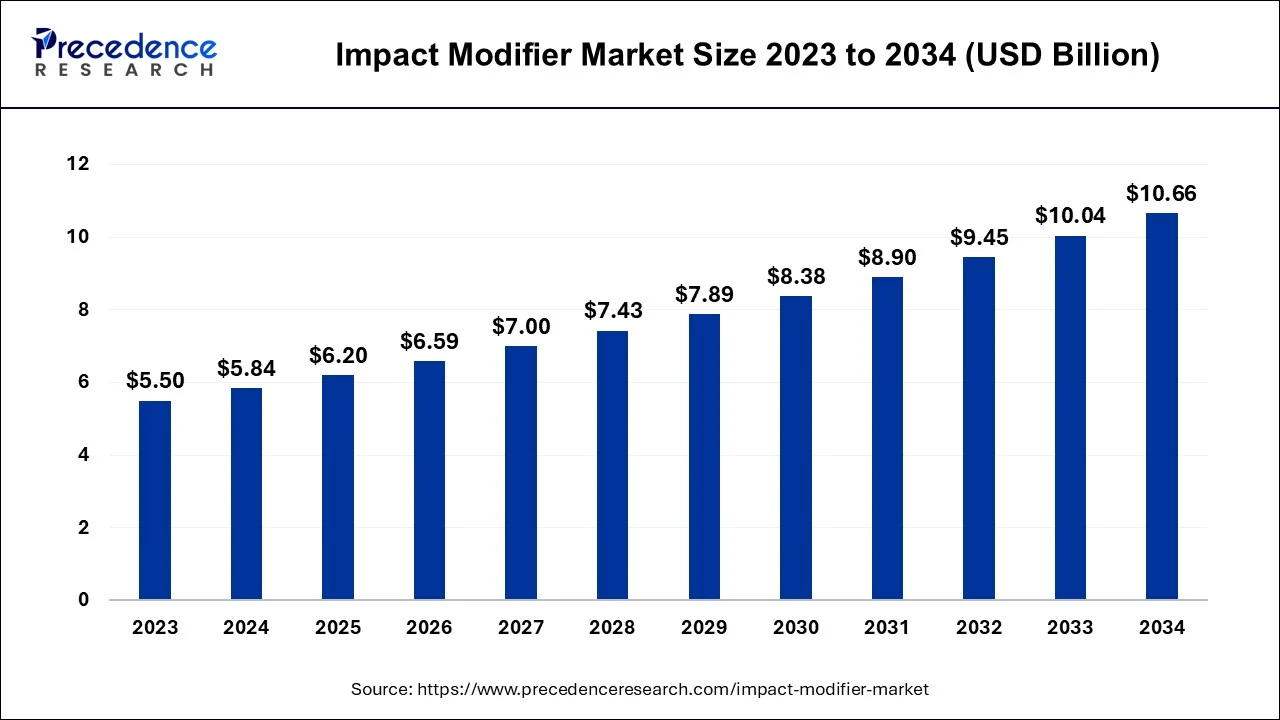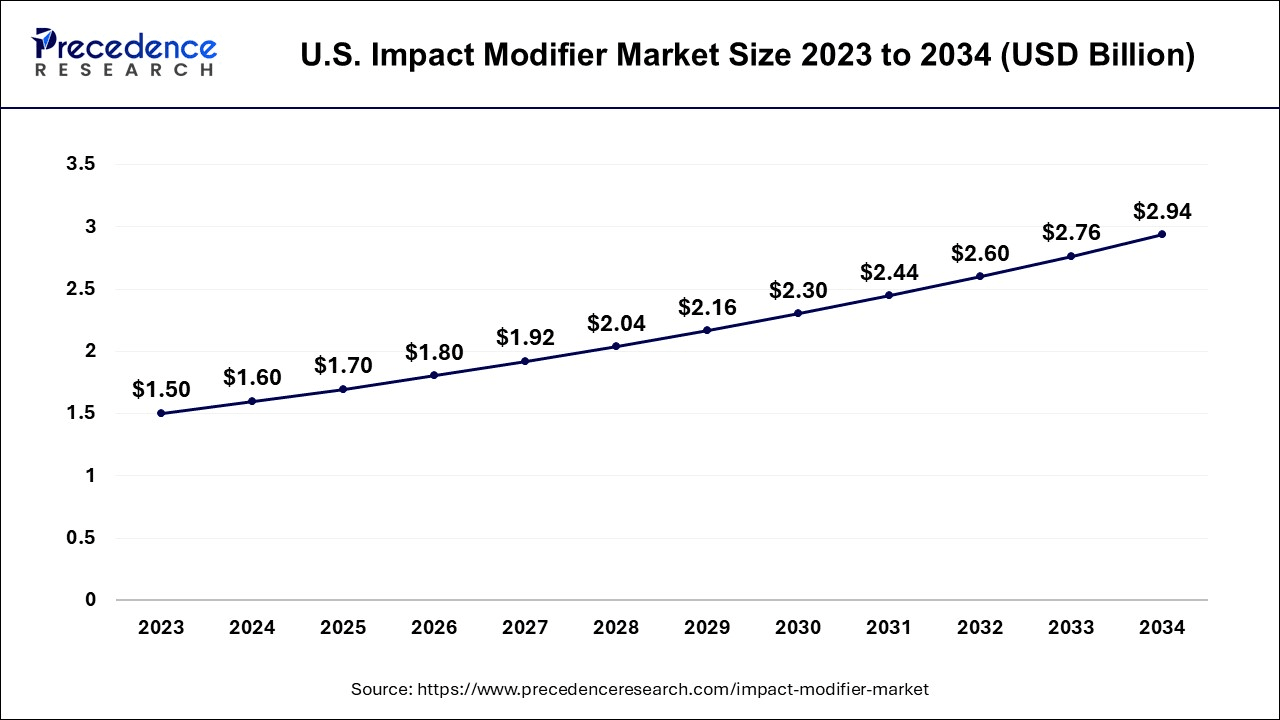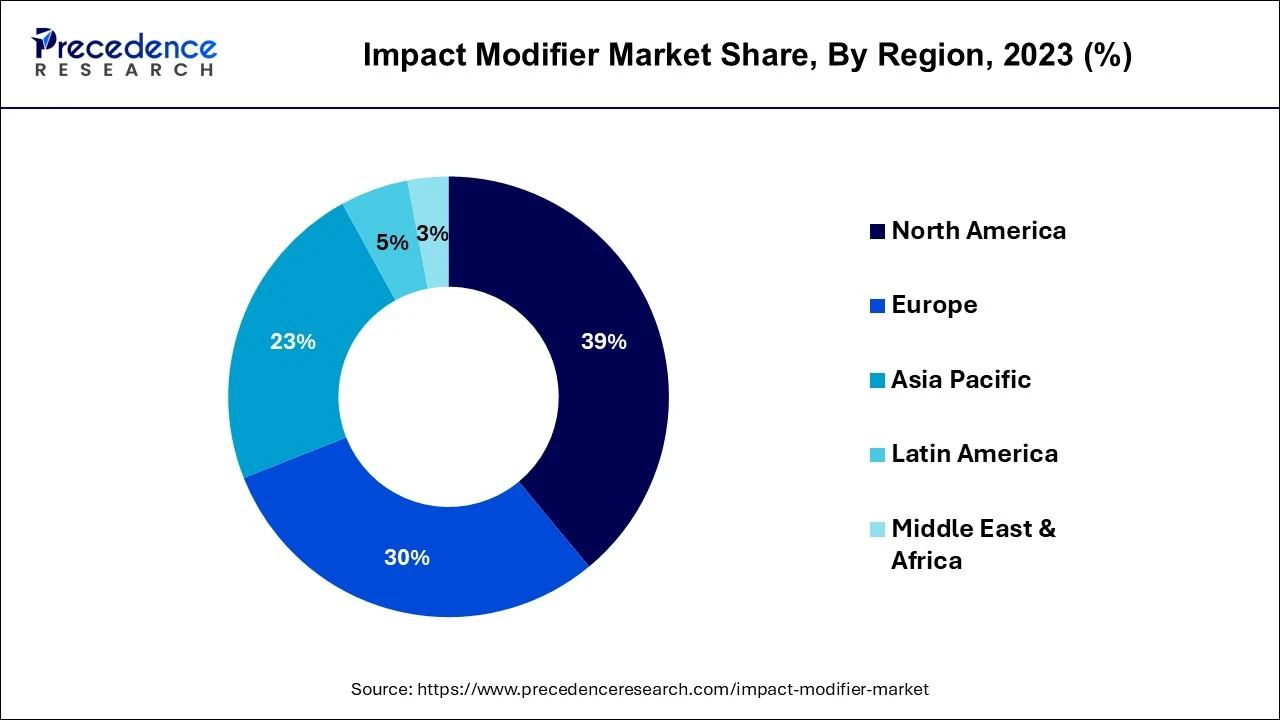August 2024
The global impact modifier market size is estimated at USD 5.84 billion in 2024, grew to USD 6.20 billion in 2025 and is predicted to surpass around USD 10.66 billion by 2034, expanding at a CAGR of 6.20% between 2024 and 2034.
The global impact modifier market size accounted for USD 5.84 billion in 2024 and is anticipated to reach around USD 10.66 billion by 2034, growing at a CAGR of 6.20% between 2024 and 2034.

The U.S. impact modifier market size is estimated at USD 1.60 billion in 2024 and is expected to be worth around USD 2.94 billion by 2034, at a CAGR of 6.28% from 2024 to 2034.

North America held the largest revenue share of 39% in 2023. The impact modifier market in North America is marked by a trend towards sustainable and eco-friendly solutions. Regulatory pressures and consumer preferences for environmentally responsible materials are driving the adoption of sustainable impact modifiers in industries like automotive and construction. Additionally, there is a growing emphasis on customized formulations to meet the specific requirements of various applications, such as packaging and consumer goods, ensuring optimal impact resistance.

Asia Pacific is estimated to observe the fastest expansion. In Asia Pacific, the impact modifier market is witnessing robust growth driven by the expanding construction and automotive sectors. There's an increasing need for durable and impact-resistant materials in these industries, along with a focus on lightweight solutions. As a result, the demand for impact modifiers to enhance the performance of plastics in various applications is on the rise, positioning Asia Pacific as a key growth region for the market.
In Europe, the impact modifier market is characterized by a strong emphasis on sustainability and innovation. Industries are progressively adopting eco-friendly and custom-tailored impact modifiers to meet stringent environmental regulations and consumer demand for cleaner, high-performance materials. As safety and regulatory standards evolve, European industries are turning to advanced impact modifiers to ensure compliance and durability in various applications, contributing to market growth and the development of cutting-edge solutions.
The impact modifier market is a segment of the chemical industry focused on additives used to enhance the impact resistance and toughness of plastics. These modifiers are incorporated into polymer formulations to improve the material's ability to withstand impact and stress without breaking or cracking. The impact modifier market is integral to various industries, including automotive, construction, packaging, and consumer goods, where the ability to withstand impact is essential. It is propelled by the demand for robust and secure materials, accentuating the use of lightweight, high-performance plastics. These plastics play a pivotal role in the production of items like automotive parts, construction materials, pipes, and packaging, where enhanced impact resistance and durability are vital characteristics.
| Report Coverage | Details |
| Market Size in 2024 | USD 5.84 Billion |
| Market Size by 2034 | USD 10.66 Billion |
| Growth Rate from 2024 to 2034 | CAGR of 6.20% |
| Largest Market | North America |
| Base Year | 2023 |
| Forecast Period | 2024 to 2034 |
| Segments Covered | Type, Application, End-user, and Region |
| Regions Covered | North America, Europe, Asia-Pacific, Latin America, and Middle East & Africa |
Demand for durable materials and lightweight plastics
The surging demand for durable materials is a primary driver of the impact modifier market. In sectors where the integrity and safety of products are of utmost importance, such as construction and consumer goods, the demand for strong and resilient plastics is indisputable. In such applications, impact modifiers are instrumental in fortifying these materials, ensuring they can endure wear and tear, thereby guaranteeing the durability and safety of the final products. As consumers continue to expect products that stand the test of time, the market experiences a steady influx of demand for impact modifiers to fortify various materials, from packaging to construction materials.
The growing emphasis on lightweight, high-performance plastics, particularly in the automotive sector, is a significant driver. Automakers strive to reduce vehicle weight to enhance fuel efficiency and performance. However, achieving this goal without compromising impact resistance is challenging. Impact modifiers enable the development of lightweight materials that meet both safety and environmental standards, making them invaluable in the pursuit of lighter, more efficient automotive solutions. As the automotive industry and other sectors increasingly prioritize weight reduction, the demand for impact modifiers surges, thus propelling market growth.
Product compatibility, cost, and pricing pressure
A significant restraint in the impact modifier market is the challenge of achieving the right balance of impact modifiers with other components in complex product formulations. Compatibility issues can arise, affecting the overall performance of the final product. For instance, in automotive manufacturing, impact modifiers must integrate seamlessly with various plastic components to maintain structural integrity and safety. Any compatibility issues can result in product defects, performance degradation, or higher production costs. Overcoming these challenges often requires extensive testing and custom formulations, increasing development time and costs.
The cost of incorporating impact modifiers into plastic formulations can be a restraint for manufacturers, particularly for smaller businesses. These additives add expenses to the production process, affecting the overall cost of manufacturing. As a result, companies may face pricing pressure, especially in competitive markets. Striking a balance between product quality and pricing becomes crucial, as consumers seek cost-effective solutions without compromising performance. Manufacturers must find ways to remain competitive while managing the increased expenses associated with impact modifiers, which can be challenging and may affect profitability.
Customized formulations, innovation and sustainability
The surge in market demand for impact modifiers is significantly driven by the development of customized formulations. Industries are increasingly seeking tailored impact modifier solutions designed to enhance performance in specific applications. This customization allows for precise adjustments to meet the unique requirements of diverse industries, such as automotive, construction, and packaging. The ability to fine-tune impact modifiers for particular applications not only ensures optimal product compatibility but also fosters their adoption in a wide range of manufacturing processes.
Innovation is a key catalyst in propelling the market demand for impact modifiers. The industry continually seeks groundbreaking solutions that offer enhanced performance and versatility. Novel technologies, such as sustainable impact modifiers, address both consumer demand for eco-friendly materials and regulatory requirements. These innovative products not only enhance impact resistance but also cater to environmental concerns, making them attractive to a broader spectrum of industries.
Moreover, the focus on sustainability is a major driver for impact modifiers. As environmental consciousness grows, industries seek impact modifiers that align with eco-friendly practices. Sustainable impact modifiers are derived from renewable sources and are biodegradable, minimizing environmental impact. This eco-conscious approach resonates with consumers and industries alike, surging the demand for impact modifiers that not only bolster performance but also support environmental responsibility.
According to the type, the acrylonitrile butadiene styrene segment has held a 36% revenue share in 2023. ABS impact modifiers are polymer additives that enhance the impact strength and toughness of ABS plastics. These modifiers improve the overall performance of ABS resins, making them suitable for a wide range of applications, including automotive parts, pipes, and consumer goods. A notable trend in ABS impact modifiers is the development of sustainable and eco-friendly formulations to align with the industry's shift towards greener practices, offering improved impact resistance without compromising environmental responsibility.
The acrylic impact modifiers segment is anticipated to expand at a significant CAGR of 7.8% during the projected period. Acrylic impact modifiers are additives used to enhance the impact resistance of various plastics, including PVC and engineering plastics. These modifiers are essential in applications where durability and toughness are crucial, such as construction materials and rigid packaging. A trend in acrylic impact modifiers is their increasing use in sustainable and recyclable plastics to meet eco-conscious consumer demands while maintaining the desired impact resistance in end products.
Based on the application, the polyvinyl chloride segment held the largest market share of 34% in 2023. In the impact modifier market, PVC applications are a prominent driver. PVC is a widely used thermoplastic with applications in construction, automotive, and packaging. The demand for impact modifiers in PVC products is increasing due to the need for enhanced impact resistance, especially in construction materials like pipes and fittings. A notable trend in this segment is the shift towards eco-friendly impact modifiers, aligning with sustainability goals in the construction industry.
On the other hand, the nylon segment is projected to grow at the fastest rate over the projected period. Impact modifiers find applications in nylon, another versatile thermoplastic used in automotive components, sports equipment, and consumer goods. The market trend in nylon applications involves custom formulations to cater to specific end-uses, improving impact strength without compromising other properties. Additionally, the demand for sustainable impact modifiers is growing in the nylon segment, meeting the increasing preference for environmentally friendly materials in the production of sports and outdoor equipment.
In 2023, the packaging segment had the highest market share of 43% on the basis of the end user. In the impact modifier market, the packaging industry seeks impact modifiers to enhance the durability of packaging materials. With a trend toward eco-friendly packaging, the use of impact modifiers aligns with the demand for sustainable and resilient packaging solutions. The industry is increasingly exploring impact modifiers that improve the impact resistance and toughness of packaging materials while also adhering to eco-conscious practices.
The consumer goods segment is anticipated to expand at the fastest rate over the projected period. In the consumer goods sector, the impact modifier market plays a vital role in enhancing the impact resistance of various products, including appliances and household items. A notable trend is the integration of impact modifiers into consumer goods to extend their lifespan, thereby meeting the demand for more durable and long-lasting products. This trend caters to consumers seeking value and reliability in their purchases.
Segments Covered in the Report
By Type
By Application
By End-user
By Geography
For inquiries regarding discounts, bulk purchases, or customization requests, please contact us at sales@precedenceresearch.com
No cookie-cutter, only authentic analysis – take the 1st step to become a Precedence Research client
August 2024
January 2025
August 2024
January 2025